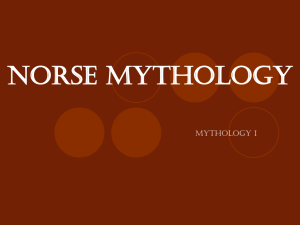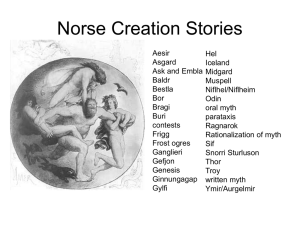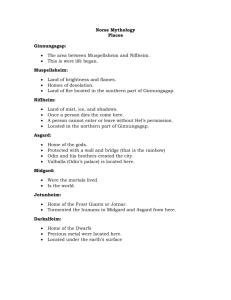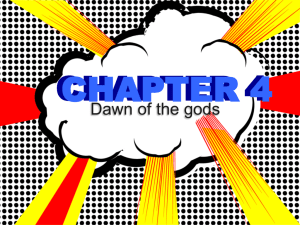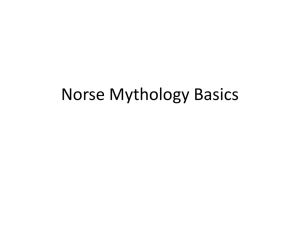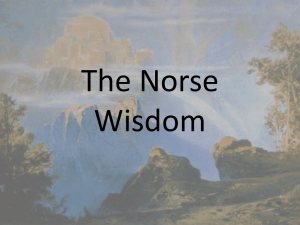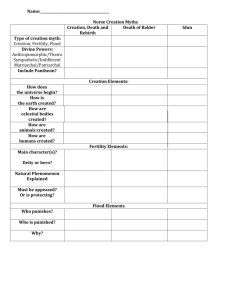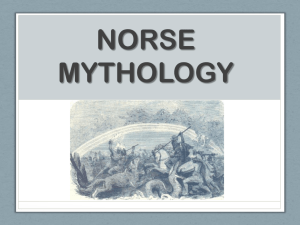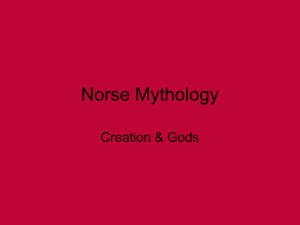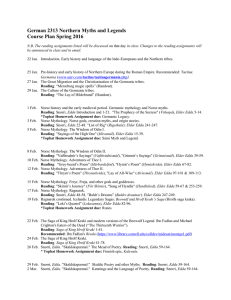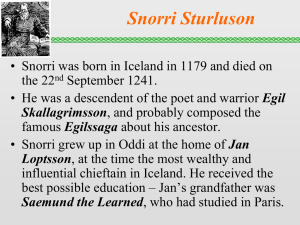Voluspa
advertisement
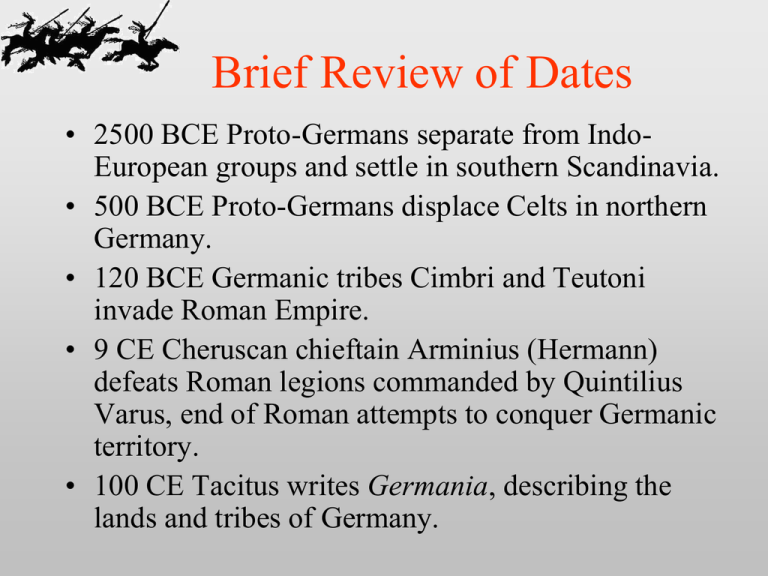
Brief Review of Dates • 2500 BCE Proto-Germans separate from IndoEuropean groups and settle in southern Scandinavia. • 500 BCE Proto-Germans displace Celts in northern Germany. • 120 BCE Germanic tribes Cimbri and Teutoni invade Roman Empire. • 9 CE Cheruscan chieftain Arminius (Hermann) defeats Roman legions commanded by Quintilius Varus, end of Roman attempts to conquer Germanic territory. • 100 CE Tacitus writes Germania, describing the lands and tribes of Germany. Dates of Völkerwanderung I • 341 Bishop Ulfilas converts Visigoths to Aryan sect of Christianity, translates bible into Gothic. • 375 Huns appear in eastern Europe, overrun the Ostrogothic King Ermenrichus. He is the basis for Jormunrek of the Volsungasaga. Beginning of dissolution of Roman Empire. • 375 CE Migration Period begins with the arrival of the Huns. • 378 Battle of Adrianople, defeat of Roman army by Gothic forces led by Fritigern. Roman borders are no longer secure after this battle. Dates of Völkerwanderung II • 436 Romans and their allies the Huns battle Burgundians in the Rheinland. • 437 Burgundian King Gundaharius dies. He is the basis for Gunnar of the Volsungasaga. • 449 Angles, Saxons, and Jutes travel to Britain as mercenaries (from the Anglo-Saxon Chronicle). • 453 Attila the Hun dies (possibly) at the hands of his new wife, the Germanic Ildico, a diminuitive form of Hild. Attila is the basis for the fictional Atli of the Volsungasaga, or Etzel of the Nibelungenlied. Dates of Völkerwanderung III • 476 Scirian chieftain Odovacar deposes last Roman Emperor, Romulus Augustulus; end of Roman Empire. • 489 Theoderic (Dietrich von Bern) deposes Odovacar, establishes Ostrogothic kingdom in Italy. Hildebrand is one of Theoderic’s most famous retainers. • c. 550 Migration Period ends. • Beginning of medieval societies and states in Europe. Migration Routes of Germanic Tribes Early Viking History I • 700 Anglo-Saxon epic Beowulf composed. It contains references to the Volsung legend. • 715 Willibrord leads first (unsuccessful) Christian mission to southern Scandinavia. • 750 Swedish Vikings establish Staraya Ladoga, a Viking colony in Russia. • 783 First Viking raid recorded in the Anglo-Saxon Chronicle. • 793 Vikings loot monastery on Lindisfarne, the Holy Island off the east coast of England. • After 795 Viking attacks on Ireland and Scotland become almost annual events for the next century. Anglo-Saxon Chronicle • “A.D. 793 This year came dreadful forewarnings over the land of the Northumbrians, terrifying the people most woefully; these were immense sheets of light rushing through the air, and whirlwinds, and fiery dragons flying across the firmament. These tremendous tokens were soon followed by a great famine, and not long after, on the sixth day before the ides of January in the same year, the harrowing inroads of heathen men made lamentable havoc in the church of God in Holyisland, by rapine and slaughter…” Early Viking History II • 800 Earliest Skaldic poetry. Charlemagne crowned Holy Roman Emperor, controls most of the European continent. • 839 Swedish Vikings reach Constantinople. • 841Viking base of Dublin established in Ireland. • 844 First Viking raid on Spain. • 860 Swedish Vikings, the Rus, attack Constantinople. • 862 Rurik, a Swedish Viking, becomes ruler of Novgorod, establishes Rus dynasty (Russia). • 862 Finns and Slavs “invite” Rurik and the Rus to rule over them, origin of Russian state. Early Viking History III • 870 Vikings begin settlement of Iceland. • 1000 Conversion of Iceland to Christianity. • 1066 Battles of Stamford Bridge and Hastings: End of the Viking Age. • 1125 Icelandic Landnamabok, Book of Settlements, written, chronicles the Age of Settlement in Iceland. • 1200 Oldest Icelandic family sagas written. • 1220 Snorri Sturluson writes the Prose Edda. • 1270 Codex Regius manuscript of the Poetic Edda written down. Gokstad ship from Museum in Oslo, Norway Norse Mythology The two most important sources for Norse mythology are: • The Elder Edda (Poetic Edda) • Snorri’s Edda (Younger or Prose Edda) The Elder Edda contains mythological poems that probably date to the period of heathen belief in Iceland (870-1000 CE). Snorri knew the poems of the Elder Edda, and he used them in his account of Norse mythology, (which he wrote sometime around 1220 CE). Who was Snorri Sturluson? • Snorri was born in Iceland in 1179 and died on 22 September 1241. • Snorri belonged to an influential family and was involved in many political conflicts in his life. He was twice elected Lawspeaker of Iceland. • He also wrote Heimskringla, a history of Norway, and probably Egilssaga about an ancestor of his. • He was one of the most important legal, political, and cultural figures in Icelandic history. Snorri’s Edda: Gylfaginning • Snorri’s Edda begins with a prologue containing a euhemeristic account of the Norse gods. Christian rationalization of pagan belief. • Gylfaginning (tricking of Gylfi) is the opening section of the Edda. Swedish King Gylfi travels in disguise to test the powerful newcomers. • Gylfi meets a tripled Odin: High, Just-as-High, and Third. • Question-and-Answer format typical for medieval texts and wisdom contests. • Insertion of poetry (e.g. Havamál) common. Snorri’s Edda: Gylfaginning • Gangleri (Gylfi) poses questions to test Odin – odd reversal, since Odin is usually the interrogator. • Who is the highest and most ancient of the gods? (8) • What was the beginning? And how did things start? And what was there before? (9) • High cites the poem Voluspá (“Prophesy of the Seeress”) in his response. • Snorri’s account of the Norse cosmos and its creation closely follows the account in Voluspá, but his version is easier to follow. • Fire and Ice at Ginnungagap created warmth and the possibility of life: First Frost-Giant Ymir. Norse Mythology: Beginnings • Where did Ymir live, and what did he live on? (11) • The cow Audhumla emerged after Ymir from the ice; her milk fed Ymir. • Audhumla licked Buri from the ice. His son Bor married giantess Bestla, gave birth to the three gods Odin, Vili and Ve. • The Frost-Giants are older than the gods; they have knowledge and power that the gods lack. • Which group was the more powerful? (11) • Odin and his brothers slay Ymir, fashion the nine worlds of the Norse cosmos from his body. Norse Mythology: Beginnings • How was the earth arranged? (12) • Where did the people come from who inhabit the world? (13) • Driftwood, Ask and Embla, are given life by the gods. • How does [Odin] control the course of the sun and moon? (14) • Who is it that inflicts this unpleasantness on [the sun]? (14) • Wolves chase the sun and the moon; Moongarm will catch and devour the sun at Ragnarök. • What way is there to heaven from earth? (15) Norse Mythology: Cosmos • Bifrost is the rainbow bridge connecting Midgard (Middle-Earth) to Asgard (realm of the Æsir). • Snorri then explains the insertion of the Dwarf List in Voluspá. They arose as maggots in the flesh of the Giant Ymir. • Where is the chief center or holy place of the gods? (17) • The great Ash Yggdrasil, the world tree, is the center of the Norse cosmos, links all of the nine worlds together. • Yggdrasil suffers much from snakes and Nidhogg. • Yggdrasil is the source of three sacred wells, in Asgard, Midgard, and Niflheim. Norse Mythology: Cosmos • Weird’s well is the home of the Norns, Weird, Verdandi, and Skuld, who allot fate to men and gods. • Mimir’s well in Midgard is the source of great wisdom – Odin sacrificed an eye for a drink from it. • Hvergelmir is another well in Niflheim. • What other chief centers are there besides the one at Weird’s Well? (19) • Alfheim is home of the Light Elves in Asgard. • Dark Elves are mentioned, but never explained. • Hlidsskialf is Odin’s throne, from which he can see into all the nine worlds. Norse Mythology: Voluspá Voluspá is the first poem contained in the Codex Regius manuscript of the Elder Edda, written down around 1270 C.E. The book was discovered in Iceland in the Renaissance and presented to the Danish king in 1643. It was returned to Iceland in the 1960s. It is the only source for most of the poems it contains. Völuspá “The Seeress’s Prophesy” • Possibly a sacred text recording the central elements of Norse cosmology – a cosmogonic or aetiological poem. • An ancient text, original material dates at least to the 10th century CE, when belief in the old gods was being supplanted by Christianity. • Unclear if the author of the poems still believes in the gods. • Two versions of text preserved; Snorri quotes extensively from the poem in his own Edda. Völuspá • Written in fornyrdislag meter, typical for narrative poems, especially heroic poems. x x Her ma Hodbroddr x x Flotta traudan x x hann hefir edli x x arf Fiorsunga x x Helga kenna x x i flota midiom; x x ættar thinnar x x und sic thrungit. Here Hodbrodd may recognize Helgi, The fighter who does not flee in the midst of the fleet; The homeland of your kin, The inheritance of the Fiorsungs he has conquered. Völuspá • Odin interrogates a Volva, or shamaness / seeress, about the doom of the gods. • Odin is a magician himself and is able to compel her to speak, though she appears to do so reluctantly. • She is able to see back to the beginning of time and forward to the end of time. • She recounts aspects of several Norse myths known (at least partially) from other sources. • Völuspá describes the world of the Norse: The Norse Cosmos–Yggdrasil The great ash tree and the three levels of the Norse cosmos. Themes in Völuspá • • • • Creation of the Earth Yggdrasil Ymir The Æsir and the golden age of the gods • List of dwarfs • Creation of man and woman, Ask and Embla • Gullveig, a woman well versed in magic. • War with Vanir • Death of Baldr • Fimbulvetr • Ragnarok • Death of Odin and Thor • Rebirth after the Fire Norse Cosmos / Origins • Some of the myths described by Snorri are a little different in Völuspá. • Ask and Embla (17-18). • Yggdrasil and the Norns (19-20). Images of the three Norns at the Well of Urd – Urd, Verdandi, and Skuld (Fated, Becoming, Must-be) I. Asgard • Yggdrasil – the mighty ash at the center of the world. • Asgard is the home of the gods, realm of the Æsir. • Well of Urd. Three Norns have a hall beside the well (Urd [weird], Verdandi, Skuld). • Vanaheim – original home of the Vanir, now at peace with the Æsir. • Alfheim – home of the elves, or bright elves. • Valhalla – hall of the slain warriors (Einheriar), half chosen by Odin, others to Freja (Volkfangr). Vigrid – a vast plain, stretching 120 leagues in every direction, site of Ragnarok. The First Cow, Audhumla Asgard Bifrost and the Norse Gods II. Midgard • Midgard is the home of men (literally middle-earth). • Bifrost – the rainbow bridge (flaming bridge) connects Midgard to Asgard. • Spring of Mimir – Odin sacrificed an eye to have a single draught from it, wisdom. • Nidavellir – underground land of the dwarves, dangerous magical goldsmiths. • Svartalfheim – home of black elves, very different from bright elves! Dwarves? • Jotunheim – land of the Frost-Giants, located far to the east and north, beyond mountains. III. Niflheim • Niflheim is the realm of the dead (literally home of fog) “9 days ride north and down.” • Hel – the offspring of Loki, half dead and half living, also her tower/realm. • Spring of Hvergelmir – a source of 7 rivers, one of the roots of Yggdrasil. • Nidhogg – giant dragon gnawing on the roots of Yggdrasil, with many snakes as well. • Muspell – land of fire, located to the south. • Naglfari, largest ship ever built (of dead men’s finger nails), is in Muspell, will appear at Ragnarok. Völuspá Myths • The First War; Gullveig (Bright-One of the Vanir–Freya?) arrives in Odin’s hall and causes mischief (21-27). • Valkyries (choosers of the slain) listed (30). • Death of Baldr foretold (31-32). • Binding of Loki as vengeance for Baldr (34-35). • Events preceding Ragnarök: Garm, Fimbulvetr, Heimdal’s horn, (38-49). • Ragnarök (doom of the gods) described: the Æsir advance against the Frost-Giants and die (50-58). • Rebirth from the ashes, Baldr, Hænir, Hod return, people survive, a new golden age (59-66). Images of Ragnarok List of Rig / Rigsthula • Poem is concerned with explaining the beginnings of human society. • An aetiological myth, explaining origins of class. • Heimdall calls himself “Rig,” a Celtic name for king (like Latin rex). Originally Odin? • Heimdall visits three families and engenders three classes of society, each given symbolic names. • Fragmentary poem breaks off after the appearance of the child in the highest class, “king.” Home of Great-Grandparents • They serve him a coarse loaf of bread and boiled calf-meat. • He sleeps between the two for three nights. • Nine months later, Great-Grandmother has a boy named “Thrall” (slave) who grows strong, but is ugly and dirty. • Thrall marries “Slavegirl” and she gives birth to many ill-named sons and daughters (248). • Thrall and Slavegirl and their family work hard in the fields and look after animals. • From these two come the race of slaves. Home of Grandparents • Their hut has more possessions and better furnishings, with industrious owners who wear nice clothes. • Heimdall sleeps between the two for the next three nights, then leaves. • Nine months later, Grandmother gives birth to “Farmer,” who is rosy-cheeked and grows strong and capable. • He marries a pretty girl called “daughter-in-law” and has many sons and daughters with beautiful and happy names (249). • From these descend the race of farmers—the vast majority of freemen belonged to this class. Home of Parents • Wealthy owners of last home, man busy with weapons and woman with fine dress. • They serve him an elegant meal, with silver dishes and wine, roast birds and light pork. • Heimdall sleeps between mother and father for three nights. • Nine months later, Mother gives birth to “Lord,” a dashing young boy, who learns to make and use weapons, hunt, and swim. Lord and Kin • Rig (Heimdall) reappears to young Lord, teaches him runes, gives him a name, tells him that he is his son. • Rig tells Lord he must reclaim his ancestral territory. • Lord rides to a hall, begins a battle, reddens the plain with blood as he fights for his land. • He rules over many settlements, bestows wealth to his followers, gains honor and prestige. • He marries Erna, daughter of Chieftain, who gives birth to sons and daughters with noble names (251). • Youngest son, Kin, understands runes and magic, speaks with birds and charms them. A raven tells Kin he should be leading armies instead of hunting. • Final line mentions “Dan,” legendary king of Denmark.
